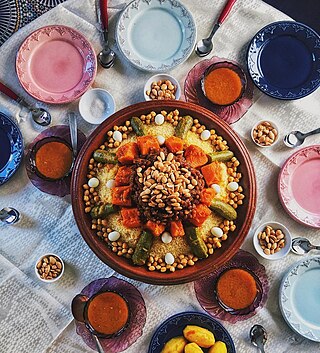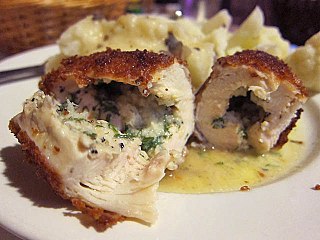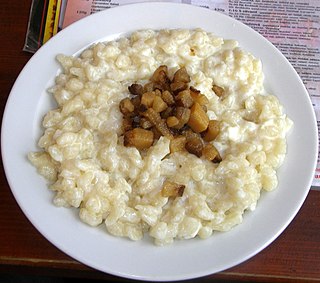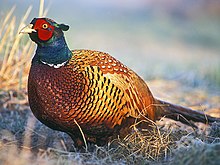
Couscous is a traditional North African dish of small steamed granules of rolled semolina that is often served with a stew spooned on top. Pearl millet, sorghum, bulgur, and other cereals are sometimes cooked in a similar way in other regions, and the resulting dishes are also sometimes called couscous.

French cuisine is the cooking traditions and practices from France. In the 14th century, Guillaume Tirel, a court chef known as "Taillevent", wrote Le Viandier, one of the earliest recipe collections of medieval France. In the 17th century, chefs François Pierre La Varenne and Marie-Antoine Carême spearheaded movements that shifted French cooking away from its foreign influences and developed France's own indigenous style.

The cuisine of Germany consists of many different local or regional cuisines, reflecting the country's federal history. Germany itself is part of the larger cultural region of Central Europe, sharing many culinary traditions with neighbouring countries such as Poland and the Czech Republic. In Northern Europe, in Denmark more specifically, the traditional Danish cuisine had also been influenced by German cuisine in the past, hence several dishes being common between the two countries.

Korean cuisine has evolved through centuries of social and political change. Originating from ancient agricultural and nomadic traditions in Korea and southern Manchuria, Korean cuisine reflects a complex interaction of the natural environment and different cultural trends.

Apple sauce is a purée made of apples. It can be made with peeled or unpeeled apples and can be spiced or sweetened. Apple sauce is inexpensive and is widely consumed in North America and some parts of Europe.

Ceviche, cebiche, sebiche, or seviche is a dish consisting of fish or shellfish marinated in citrus and seasonings, and is recognized by UNESCO as an expression of Peruvian traditional cuisine and Intangible Cultural Heritage of Humanity. Different versions of ceviche are part of the culinary culture of various Spanish-American countries along the Pacific Ocean where each one is native: Chile, Colombia, Costa Rica, Ecuador, El Salvador, Guatemala, Honduras, Mexico, Nicaragua, Panama and Peru. In Peru it is also considered a flagship dish and cultural heritage.

Shepherd's pie, cottage pie, or in French cuisine hachis Parmentier, is a savoury dish of cooked minced meat topped with mashed potato and baked, also called Sanders or Saunders. The meat used may be either previously cooked or freshly minced. The usual meats are beef or lamb. The terms shepherd's pie and cottage pie have been used interchangeably since they came into use in the late 18th and early 19th centuries, although some writers insist that a shepherd's pie should contain lamb or mutton, and a cottage pie, beef.

Sheep meat is one of the most common meats around the world, taken from the domestic sheep, Ovis aries, and generally divided into lamb, from sheep in their first year, hogget, from sheep in their second, and mutton, from older sheep. Generally, "hogget" and "sheep meat" are not used by consumers outside Norway, New Zealand, South Africa, Scotland, and Australia. Hogget has become more common in England, particularly in the North often in association with rare breed and organic farming.

Ajvar is a condiment made principally from sweet bell peppers and eggplants. The relish became a popular side dish throughout Yugoslavia after World War II and remains popular in Southeast Europe.

In English, kasha usually refers to the pseudocereal buckwheat or its culinary preparations. In Eastern European cuisine, kasha can apply to any kind of cooked grain. It can be baked but most often is boiled, either in water or milk, and therefore the term coincides with the English definition of 'porridge', but the word can also refer to the grain before preparation, which corresponds to the definition of 'groats'. Kasha is eaten widely in Belarus (каша), the Czech Republic, Lithuania, Poland, Romania and Moldova, Russia (каша), Slovakia, Slovenia, Kazakhstan, and Ukraine (каша), where the term, besides buckwheat, can apply to wheat, barley, oats, millet, rye and even rice. Kasha has been an important element of Slavic diet for at least 1,000 years.

Chicken Kiev, also known as chicken Kyiv and chicken à la Kyiv, is a dish made of chicken fillet pounded and rolled around cold butter, then coated with egg and bread crumbs, and either fried or baked. Since fillets are often referred to as suprêmes in professional cookery, the dish is also called "suprême de volaille à la Kiev". Stuffed chicken breast is generally known in Russian and Ukrainian cuisines as côtelette de volaille. Though it has disputed origins, the dish is particularly popular in the post-Soviet states, as well as in several other countries of the former Eastern Bloc, and in the English-speaking world.

Choux pastry, or pâte à choux, is a delicate pastry dough used in many pastries. The essential ingredients are butter, water, flour and eggs.

Matzah balls or matzo balls are Ashkenazi Jewish soup morsels made from a mixture of matzah meal, beaten eggs, water, and a fat, such as oil, margarine, or chicken fat. Known as knaidel in Yiddish, they resemble a matzah meal version of knödel, bread dumplings popular throughout Central European and East European cuisine.

Cellophane noodles, or fensi, sometimes called glass noodles, are a type of transparent noodle made from starch and water. A stabilizer such as chitosan may also be used.

Somali cuisine was influenced by many different countries mainly due to trade, but traditionally also varies from region to region due to the expansive landmass Somalis inhabit. It is the product of Somalia's tradition of trade and commerce. Some notable Somali specialties include kimis / sabaayad, canjeero / laxoox, xalwo (halwa), sambuusa (samosa), bariis iskukaris, and muqmad / oodkac.

Ottoman cuisine is the cuisine of the Ottoman Empire and its continuation in the cuisines of Greece, Turkey, the Balkans, Caucasus, Middle East and Northern Africa.

Egyptian cuisine makes heavy use of poultry, legumes, vegetables and fruit from Egypt's rich Nile Valley and Delta. Examples of Egyptian dishes include rice-stuffed vegetables and grape leaves, hummus, falafel, shawarma, kebab and kofta. Others include ful medames, mashed fava beans; koshary, lentils and pasta; and molokhiyya, bush okra stew. A local type of pita bread known as eish baladi is a staple of Egyptian cuisine, and cheesemaking in Egypt dates back to the First Dynasty of Egypt, with Domiati being the most popular type of cheese consumed today.

Century eggs, also known as alkalized or preserved egg, are a Chinese egg-based culinary dish made by preserving duck, chicken, or quail eggs in a mixture of clay, ash, salt, quicklime, and rice hulls for several weeks to several months, depending on the processing method.

Traditional foods are foods and dishes that are passed on through generations or which have been consumed for many generations. Traditional foods and dishes are traditional in nature, and may have a historic precedent in a national dish, regional cuisine or local cuisine. Traditional foods and beverages may be produced as homemade, by restaurants and small manufacturers, and by large food processing plant facilities.

André Noël, born in Périgueux in 1726 and died in Berlin on May 4, 1801, was a French chef in the service of King Frederick II of Prussia. He created famous dishes for the royal table, such as a "bombe de Sardanapale", but is also credited with making a pheasant pâté that La Mettrie is said to have enjoyed to the point of dying of indigestion. In 1772, King Frederick II dedicated a long poem to him. After his death, he appeared in several novels.




















